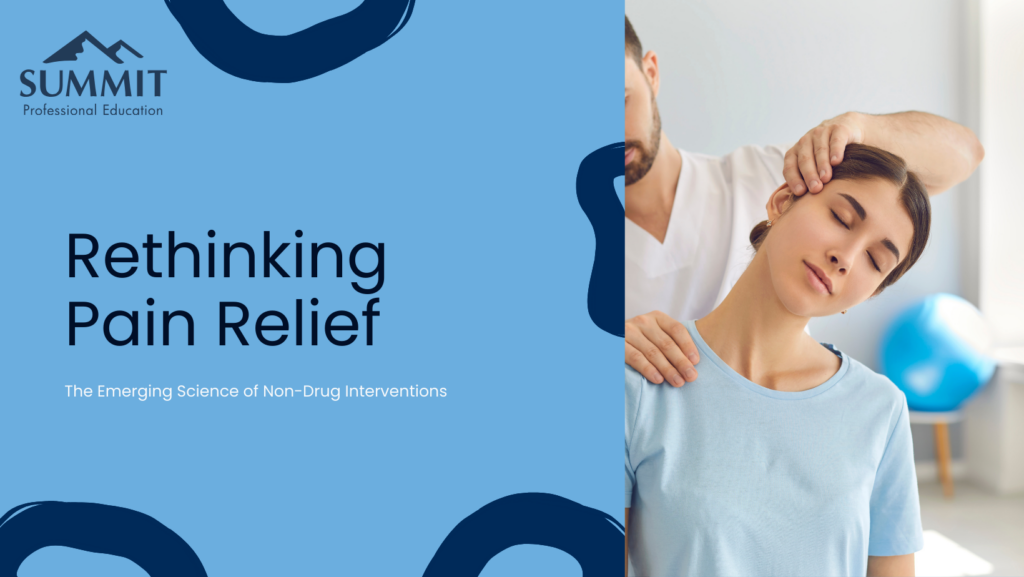Written by the Summit Professional Education Team, experts in continuing education for healthcare and allied professionals
In an era defined by rising healthcare costs, insurance restrictions, and growing patient dissatisfaction, the question of how to manage pain without pharmacological intervention is not merely clinical—it is deeply strategic. For physical and occupational therapists, the conversation around non-drug pain interventions is not new, but the stakes are higher than ever. The prevailing emphasis on quick fixes and cost-cutting has often led to diminished outcomes, fractured trust, and a workforce on the brink of burnout. Against this backdrop, emerging research on non-drug pain therapies offers more than clinical insight—it points toward a transformation in how care is delivered, valued, and sustained.
The current healthcare system is structured around efficiency. Time with patients is shrinking, documentation burdens are rising, and revenue models are skewed toward volume rather than value. In this environment, relationship-centered care—a model that prioritizes the therapeutic alliance between clinician and patient—is often deprioritized. Yet, it is precisely this model that research is increasingly validating as essential to effective pain management.
Non-drug pain interventions, when viewed through this lens, become more than a set of techniques—they are a vehicle for rebuilding trust, improving outcomes, and enhancing long-term engagement. Techniques such as manual therapy, graded motor imagery, therapeutic exercise, cognitive-behavioral approaches, and patient education all depend on clinician expertise, but equally on time, empathy, and communication. These are not interchangeable with a prescription pad; they require presence and partnership.
Recent meta-analyses have shown that manual therapy, particularly when combined with exercise and education, can significantly reduce pain and improve function across a range of musculoskeletal conditions. Cognitive functional therapy, an approach that integrates biopsychosocial principles, has demonstrated superior outcomes to traditional modalities in managing chronic low back pain. These interventions emphasize adaptability, patient engagement, and behavioral change—all of which are incompatible with a rushed, transactional approach to care.
This has direct implications for recruitment and retention. Talented therapists are increasingly seeking workplaces that allow them to practice at the top of their license, in environments that align with their values. Clinics that prioritize relationship-centered, non-drug interventions offer a compelling employer value proposition: time with patients, space for creativity, and a culture that sees clinicians as partners in care, not cogs in a productivity machine.
The value of this approach also extends to continuing education. Too often, CE is treated as a compliance requirement—something to be checked off rather than integrated into daily practice. But when CE is aligned with evidence-based, non-drug approaches to pain management, it becomes a pathway for professional growth and clinical mastery. Investing in CE that deepens therapists’ skills in manual therapy, neuroscience-based education, and pain science is not only a retention strategy—it’s a catalyst for culture change.
Upskilling in these domains must be intentional and scaffolded. A one-off weekend course is insufficient. Clinics need to build learning ecosystems—peer mentorship, journal clubs, integrated case reviews—that reinforce the principles of evidence-based, relationship-centered pain care. These structures foster not only competence but also community, a critical buffer against burnout.
Speaking of burnout, non-drug pain interventions hold promise here as well. Research on therapist burnout consistently identifies lack of autonomy, emotional exhaustion, and a sense of futility as core drivers. Relationship-centered care, particularly in the context of pain management, counters each of these forces. It restores purpose, rewards emotional labor, and places clinicians in a role of influence and agency.
Technology, often viewed as a threat to human connection in healthcare, can play a supporting role if deployed wisely. Digital tools that support exercise adherence, track pain trends, and enable asynchronous communication can extend the therapeutic alliance beyond the clinic walls. However, these tools must augment, not replace, the human relationship. Used strategically, they can free up therapist time for the deeper work of pain education and motivational interviewing.
Looking ahead, the future of pain care will likely be defined by integration—of disciplines, of modalities, and of data. The silos between PT, OT, psychology, and primary care are increasingly untenable. Value-based care models will demand coordination and outcomes that reflect more than symptom reduction. In this landscape, non-drug interventions will not be “alternative”—they will be foundational.
This shift also opens up new avenues for business model innovation. Clinics that embed non-drug pain management into bundled payment models, or partner with employers on injury prevention and recovery, can demonstrate measurable ROI. Reducing reliance on pharmacologic treatments, particularly opioids, is not only clinically wise—it is fiscally prudent and reputationally strategic.
But perhaps most importantly, non-drug pain interventions reframe the role of the therapist. No longer a technician executing protocols, the modern therapist is a guide, a coach, and an advocate. This is the clinician patients remember, the one who listens, adjusts, and walks the road of recovery alongside them. This is the clinician who stays—not because they are paid the most, but because they are valued, developed, and supported in doing meaningful work.
In conclusion, the latest research on non-drug pain interventions is not simply a call to update treatment plans—it is a call to reimagine care. For PTs and OTs, this means moving beyond the quick fix to the deeper fix: building therapeutic relationships that endure, fostering teams that grow together, and creating systems that heal patients and clinicians alike. It’s time to stop asking how fast we can deliver care, and start asking how well we can deliver healing.
About Summit Professional Education
Summit equips Physical Therapists, Occupational Therapists and SLPs with better continuing education courses that provide CEUs while impacting patient outcomes. Find high-quality on-demand CE along with the largest offering of live options — including live webinars, live streams, and in-person courses. Want to deep dive on a topic? Summit offers hundreds of 6-hour courses for the most in-depth learning!
